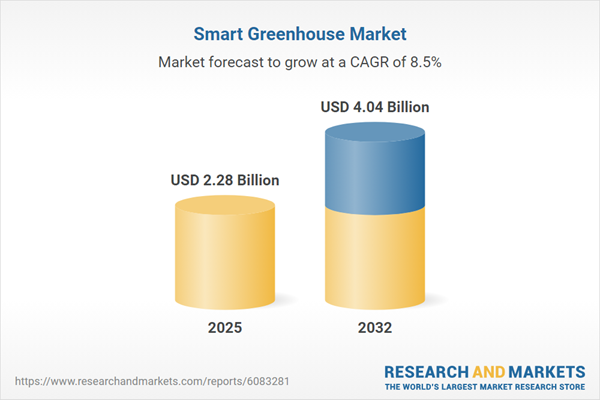Speak directly to the analyst to clarify any post sales queries you may have.
Smart greenhouse technology is reshaping modern agriculture by enabling precise, automated control over growing environments. For senior decision-makers seeking data-driven ways to optimize agricultural performance, the expanding smart greenhouse market offers actionable strategies for enhanced yields, resource use, and operational resilience.
Market Snapshot: Smart Greenhouse Market Growth and Dynamics
The Smart Greenhouse Market grew from USD 2.10 billion in 2024 to USD 2.28 billion in 2025. It is expected to continue growing at a CAGR of 8.53%, reaching USD 4.04 billion by 2032. This growth trajectory underscores sustained adoption of technology-led greenhouse solutions and heightened focus on sustainable food production. Leading industry stakeholders are integrating digital, automation, and environmental control technologies to create value across diverse cultivation environments and supply chains.
Scope & Segmentation of the Smart Greenhouse Market
The report delivers a comprehensive review of the market’s full value chain, from hardware to service and software innovation, and profiles emerging regional and industry trends shaping adoption.
- Offering Types: Environment control systems, irrigation systems, lighting systems, structural coverings, consulting services, maintenance services, data management software, security and access software.
- Technology Solutions: Aeroponic systems, aquaponic systems, hydroponic configurations (including deep water culture, drip systems, ebb and flow, nutrient film technique), and soil-based approaches.
- Automation Levels: Fully automated, semi-automated, and manual management setups support various operational preferences.
- Applications: Commercial greenhouses, research installations, and residential environments shape market demands.
- End User Segments: Floriculture, fruit cultivation, and vegetable cultivation each present unique requirements and innovation drivers.
- Geographic Regions Covered: Americas (United States, Canada, Mexico, Brazil, Argentina, Chile, Colombia, Peru), Europe (United Kingdom, Germany, France, Russia, Italy, Spain, Netherlands, Sweden, Poland, Switzerland), Middle East (United Arab Emirates, Saudi Arabia, Qatar, Turkey, Israel), Africa (South Africa, Nigeria, Egypt, Kenya), and Asia-Pacific (China, India, Japan, Australia, South Korea, Indonesia, Thailand, Malaysia, Singapore, Taiwan).
- Notable Companies: Agnetix, Heliospectra AB, GrowFlux, Argus Control Systems Limited, Autogrow, iUNU, Inc., Phenospex, Ceres Greenhouse Solutions, Sollum Technologies, Solar Impulse Foundation, Cultivar Ltd., Certhon Build B.V.
Key Takeaways for Strategic Decision-Makers
- Integrated automation and IoT sensor networks enable growers to optimize resources, lower operational costs, and adapt to changing climate or supply conditions in real time.
- Demand for sustainable agriculture and predictable yields accelerates the adoption of energy-efficient climate controls and modular production systems across large commercial installations.
- Consulting and maintenance service offerings are essential for performance optimization, ensuring operational continuity and seamless technology integration for large and small operations alike.
- Software platforms supporting advanced analytics, remote monitoring, and secure collaboration drive improvements in management processes and boost transparency across the value chain.
- Specialized hardware and software innovation create value for distinct end-user segments, including floriculture, fruit, and vegetable producers, through customizable lighting, climate stability, and faster crop cycles.
Tariff Impact on Supply Chain and Market Dynamics
United States tariff policies in 2025 have driven up capital costs for imported greenhouse components such as LED lighting systems, sensors, and structural materials. In response, solution providers are localizing assembly and partnering with domestic manufacturers to offset increased expenses and ensure reliable supply. Modular designs and prefabricated greenhouses are increasingly used to reduce dependencies on imports, while service providers offer performance-based maintenance to help amortize cost burdens and maintain grower competitiveness within the evolving policy landscape.
Methodology & Data Sources
This research utilizes a mixed-methodology approach, including primary interviews with industry experts, growers, and technology providers. Findings are supported by analysis of financials, regulatory filings, peer-reviewed publications, and case studies. An iterative validation process with subject matter experts ensures data reliability and analytical rigor across every market segment and region.
Why This Report Matters
- Enables senior leaders to benchmark technology offerings and partnerships relevant to their expansion and operational strategies.
- Provides detailed segmentation to guide investment, procurement, and innovation priorities in evolving global regions and user segments.
- Informs risk management by analyzing both regulatory impacts and service-driven value retention across supply chains.
Conclusion
By distilling actionable insights into technology, policy, and market drivers within the smart greenhouse ecosystem, this report empowers decision-makers to navigate complexity, sustain growth, and build resilient, future-ready agricultural operations.
Table of Contents
3. Executive Summary
4. Market Overview
7. Cumulative Impact of Artificial Intelligence 2025
Companies Mentioned
The companies profiled in this Smart Greenhouse market report include:- Agnetix
- Heliospectra AB
- GrowFlux
- Argus Control Systems Limited
- Autogrow
- iUNU, Inc.
- Phenospex
- Ceres Greenhouse Solutions
- Sollum Technologies
- Solar Impulse Foundation
- Cultivar, Ltd.
- Certhon Build B.V.
Table Information
| Report Attribute | Details |
|---|---|
| No. of Pages | 183 |
| Published | November 2025 |
| Forecast Period | 2025 - 2032 |
| Estimated Market Value ( USD | $ 2.28 Billion |
| Forecasted Market Value ( USD | $ 4.04 Billion |
| Compound Annual Growth Rate | 8.5% |
| Regions Covered | Global |
| No. of Companies Mentioned | 13 |









